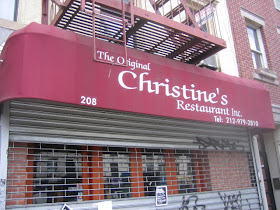Julian Brash, Ph.D., a Brooklyn-born professor of anthropology and urban studies now at Montclair State University, has written a book entitled
“Bloomberg's New York: Class and Governance in the Luxury City.” As our economy crashes and burns, with the City Council set to
vote on term limits tomorrow, I talked with Professor Brash about what he calls the Bloomberg Way and its effect on the city.
 Doctoroff & Bloomberg
What is the Bloomberg Way?
Doctoroff & Bloomberg
What is the Bloomberg Way?
It’s a notion of governance in which the city is run like a corporation. The mayor is the CEO, the businesses are clients, citizens are consumers, and the city itself is a product that’s branded and marketed. And
New York is a luxury product.
This is all about class. Bloomberg and many in his administration are asserting their right to both govern and shape the city into a place for corporate elites and high-level professionals. This is the culmination of a major shift in policy, underway since the 1970s, away from the post-war idea that working-class people are the heart of the city.
Sure, they’re saying, we need people around to fight fires and serve sandwiches, but
it’s not their city. It’s really a city for the well-off. Bloomberg realizes this vision through a privatized, top-down, outcome-based notion of government.
What effect does the Bloomberg Way have on the city?
Bloomberg’s administration is corporate, technocratic—and a touch authoritarian.
Its development agenda is Robert Moses-type stuff. A complete transformation of the city is underway. Bloomberg’s rezonings are about creating high-end commercial and residential districts. His administration aims to create an urban environment conducive to the people you call “yunnies.”
His development model is a corporate model, in which growth is a good in itself. It’s the fetishization of growth, constantly accumulating more and more and more. This leads to real problems, as the basics—especially infrastructure—have not been maintained and expanded adequately.
Many people will say: What’s wrong with that? Shouldn’t we let the Bloomberg Way continue?
The reason we keep having fiscal crises in the city is because we’re so dependant on the unstable industry of finance.
Bloomberg has not diversified the city’s economy enough to protect it. In fact, he made it worse. He created a place where only super-profitable companies, namely finance, can buy into the city.
Bloomberg is very good at short-term fiscal management and he might be able to get the city through the next couple of years of fiscal crisis. But in the long term, he isn’t the person who’s going to be able to address the basic problem of New York’s inequitable and unstable pattern of economic development.
Basically,
it’s a very bad time to be one of the financial centers of the world. The next few decades are likely to see finance decline as the leading edge of capitalism. New York’s economy will suffer from this.
Which brings us to the term limits issue.
Right. It fits right in with the whole corporate governance model for three reasons:
One, the argument goes: Bloomberg’s an excellent CEO, he’s getting things done, so why shouldn’t he continue? It’s not about making decisions in a democratic way.
Democracy doesn’t matter in his model of governance because the CEO makes the decisions.
Two, it’s personalistic. Only Bloomberg, they’re saying, only this corporate superman, a God-like figure with some internal, personalized quality that makes him exceptional, can govern the city.
The idea that in a city of 8 million people, Bloomberg’s the only person who can govern the city’s affairs is wrong and alarming.
And three, there’s the class element. Bloomberg helped to solidify the class shift in the city. A
coalescence of billionaires around Bloomberg basically asked themselves, Who among us can govern the city? Richard Parsons, the CEO of Time Warner, was a possibility, but then he decided to tend his vineyards in his retirement instead. Bloomberg was the guy interested in the job.
 Billionaires for Bloomberg: dnblog1
Most people in New York aren’t billionaires. So why aren’t we seeing a large-scale protest against Bloomberg and his policies?
Billionaires for Bloomberg: dnblog1
Most people in New York aren’t billionaires. So why aren’t we seeing a large-scale protest against Bloomberg and his policies?
Nobody’s causing a ruckus because,
in Bloomberg’s vision of the city you’re not a citizen, you’re a consumer. Citizens get rowdy. They protest in the streets, they don’t make complaint phone calls. Now we have 311, which provides great customer service, and basic services are being delivered well—no small accomplishment. But the consumer model diminishes political action because it’s so emotionally seductive.
A lot of mid-level professionals--teachers, academics, urban planners, people in publishing and non-profits, people like you and me, basically--identify with Bloomberg because they identify upward. They are so happy to be living in this shiny, elite city, that the fact they’re amassing thousands of dollars in credit card debt or are desperately house-poor to fit into the New York standard of living escapes them.
They’re getting screwed. Eventually, these people will just leave.
Marx said about the peasantry that they are “incapable of enforcing their class interest in their own name.” These professionals are the peasants here. They’re allowing themselves to be led by Bloomberg without a sense of their own class interest.
These people are the most deluded of all.
Is there any hope?
Don’t overestimate the degree to which the Bloomberg administration has changed the city.
New Yorkers are still citizens—not consumers. People are agitating against it. Political action is not dead—it’s just not being articulated in a coherent way on a city-wide level. It’s hard to tell where a coherent alternative would emerge from right now. But it's hard to believe it will not.
Check out the book here.
The following images are from a brochure Brash received at a Doctoroff speech in 2004. The brochure is entitled "Bloomberg Administration Major Economic Development Initiatives." It outlines a massive plan to transform the city. Click to enlarge:























































